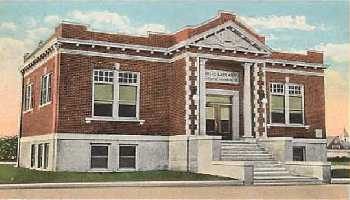
A historical survey presented by Susan Booker, University of Oklahoma, and Tanya Finchum, Oklahoma State University.

Frederick Oklahoma Carnegie Library, Carnegie grant awarded in 1914
__________________________________________________________
Oklahoma Carnegie Library General Statistics:
25 Carnegie grants to build libraries were awarded to Oklahoma towns between the years 1899 and 1916.
One of these grants was given to the University of Oklahoma in Norman, one of only 108 Carnegie Library grants to Universities in the United States. The award was granted in 1903.
8 Carnegie grants for public libraries were awarded to Oklahoma Territory and Indian Territory towns before statehood in November 1907.
16 Carnegie grants for public libraries were given to Oklahoma towns after statehood in 1907.
10 grants were given to towns that started in Indian Territory.
14 grants were given to towns that started in Oklahoma Territory.
****************************************************************************
Carnegie Libraries of Oklahoma

Map Courtesy of OSU Cartography Services
Oklahoma Carnegies in Grant Year Award Order:
| 1899 | Oklahoma City | 1905 | Tahlequah | 1911 | Cordell | 1916 | Lawton | |||
| 1901 | Guthrie | 1906 | McAlester | 1911 | Hobart | 1916 | Miami | |||
| 1903 | Ardmore | 1908 | Bartlesville | 1911 | Wagoner | 1916 | Sapulpa | |||
| 1903 | Chickasha | 1908 | Ponca City | 1914 | Elk City | |||||
| 1903 | El Reno | 1909 | Perry | 1914 | Frederick | |||||
| 1904 | Enid | 1910 | Muskogee | 1915 | Collinsville | |||||
| 1904 | Shawnee | 1910 | Tulsa | 1915 | Woodward | |||||
***************************************************************
Preface
In Oklahoma, the rough and tumble pre-statehood times before 1907, and the early years of statehood, were times when new towns were struggling to establish themselves and build schools and churches, gins and mills, opera houses and meeting halls. Efforts were underway to pave dusty streets and introduce electrical service. Street car inter-urban service linked town to town, and trains carried produce, cotton and animal hides to the North and East. Property ownership and taxation issues abounded stemming from the land runs and lotteries for territorial lands.
Many Oklahoma towns sought to take advantage of the library grant program established by Andrew Carnegie, however meeting the criteria for the grants proved sometimes to be quite difficult for the fledgling cities. Towns had to provide a lot for the building, and promise to support the library afterwards with a percentage of their tax base. Establishing this tax base, and gaining the property needed for the library building, was especially challenging for these frontier towns. Selecting appropriate plans for the buildings, and finding contractors to build them, were also difficult tasks for many cities. Pride of accomplishment and determination to establish the necessary institutions for a cultured and respectable life helped some cities persevere to gain their grants. In many cases the local women's clubs were the driving force behind the initial request and provided the follow-up needed as the projects proceeded to completion.
Several towns applied for Carnegie grants and failed to get them. Some did not meet minimum population standards, or were unable to meet the stipulations required by Carnegie for future financial support of the library after it was built. Some could not arrange a lot of land for the library for various reasons. Political maneuvering and internal strife on library committees sometimes delayed the procedures, reflecting the unsettled times in the Territories, and then new state.
The desire of the city fathers to gain a proud and stately edifice for their cities ran exactly counter to Carnegie's belief that a good library was simple, plain and useable. Squabbles over acceptable blueprints and building designs resulted in lengthy correspondence, and often a visit to New York by a town representative was required to smooth out difficulties.
Of the 24 Carnegie Libraries in Oklahoma 17 are still standing, and 4 are still serving their communities as libraries. This web page briefly documents their histories and appearances, using correspondence from the Carnegie Corporation Archives, information form local historical societies files and published literature on the Carnegie Libraries as a national phenomenon. Images are from historic postcards and current photographs.
We invite corrections, and additions of a factual nature, and hope through our efforts to create an interest in this aspect of Oklahoma's cultural history.